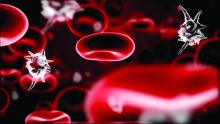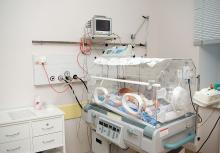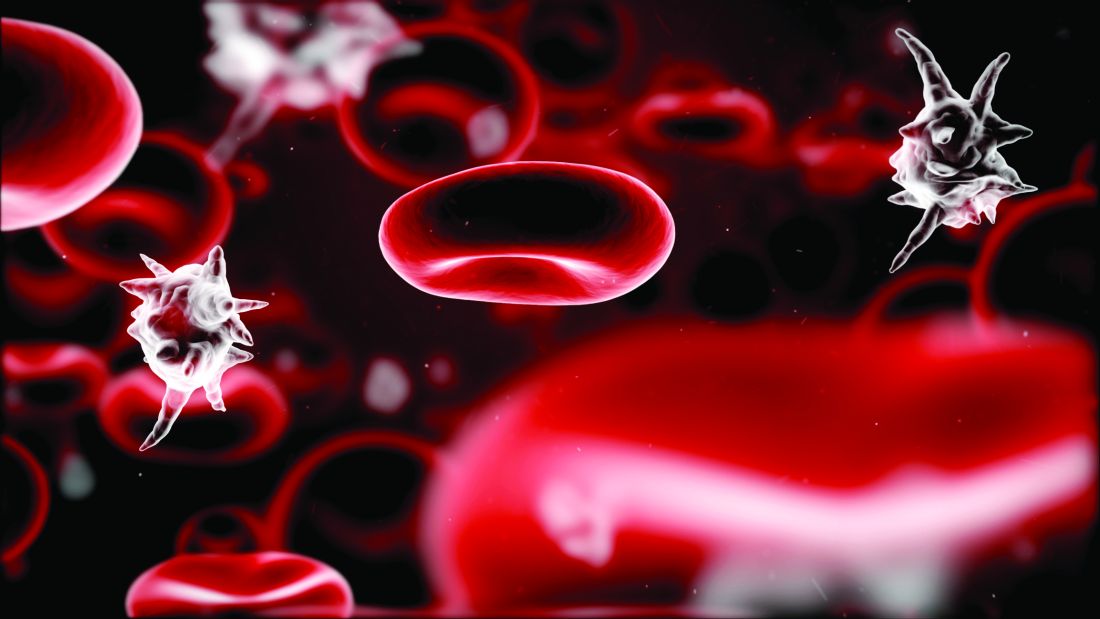User login
, according to an investigator-initiated, superiority and noninferiority, multicenter, randomized controlled intervention study.
In the Neonatal Procalcitonin Intervention Study (NeoPInS) study aimed to reduce the duration of antibiotic treatment, 1,710 neonates who were already receiving antibiotic therapy were enrolled in 18 hospitals in Canada, the Czech Republic, the Netherlands, and Switzerland, and randomized to procalcitonin-guided decision making or standard care. Some patients were excluded from the larger initial population because of congenital malformation, surgery in the first week of life, or a lack of parental consent, among other reasons.
The intention-to-treat population included 866 neonates in the procalcitonin group whose median treatment duration was 55 hours (95% confidence interval [CI], 50.5-60.0) and 844 in the standard group whose median treatment duration was 65 hours (95% CI, 63.0-69.0; P less than .0001), with a median difference of –9.9. The per-protocol population saw an even greater median difference of –12.2, with a treatment duration of 52 hours in 745 neonates assigned to procalcitonin-guided decision making (95% CI, 48.2-56.0) and a duration of 64 hours in 663 neonates assigned to standard care (95% CI, 61.0-68.1; P less than .0001).
Length of hospital stay also was significantly shorter in both procalcitonin groups, according to the researchers.
One neonate in the standard group died from the consequences of severe perinatal asphyxia. In each procalcitonin group, five (0.6% and 0.7%, respectively) had a suspected reinfection, compared with three in each of the standard groups (0.5% and 0.6%, respectively). None of the neonates suspected of reinfection had a culture-proven bacteria infection.
“In this era of globally increasing antibiotic resistance rates ... every dose of antimicrobial therapy counts in the emergence of antimicrobial resistance and in changing the human microbiome,” the investigators wrote, “and other evidence suggests that changes in the microbiome in early life are particularly important in shaping the individual’s immune system and future health.”
The primary outcomes of the study were duration of treatment and reinfection or death in the first month of life, with a secondary outcome of length of hospital stay. Noninferiority for reinfection and death could not be shown because there were too few of these events.
“Procalcitonin-guided decision making led to a significant reduction in duration of empirical antibiotic therapy and hospital stay in term and near-term neonates with suspected early-onset sepsis, with a low rate of reinfections and with no study-related mortality. Combining serial procalcitonin measurements with initial assessment based on perinatal risk factors, the neonate’s clinical signs and symptoms, and conventional laboratory variables support antimicrobial stewardship and help physicians to decide to discontinue antibiotic treatment sooner in neonates classified as having low or moderate risk of infection,” Dr. Stocker, Dr. van Herk, and their associates said.
A limitation was that results cannot be extrapolated to other populations. The neonates in this study all had easy and low-threshold access to care, so the results may not apply to low-income or low-access areas, they said.
Length of hospital stay results may be affected by other conditions developed by the neonates. “It would be interesting to analyze duration of hospital stay separately for neonates with or without other reasons for hospital admission, but this was not possible in our study design,” the investigators said.
The authors reported no relevant financial disclosures. The Thrasher Foundation, the NutsOhra Foundation, and the Sophia Foundation for Scientific Research funded the study.
Dr. Stocker, Dr. Herk, and their coauthors “are to be commended for conducting this pragmatic and international, multicenter trial.” When withholding antibiotics, especially from neonates who are susceptible to infection, safety is key. In this “landmark study done in neonates,” the authors determined that procalcitonin can be safely used to guide decision making in neonates at low risk of sepsis. Using procalcitonin in a clinical algorithm also was effective, reducing the duration of antibiotic therapy by around 20% and the length of hospital stay by around 5%.
Although the biomarker is the most accurate diagnostic tool currently available, it should be used with caution. On its own, it is not enough to determine if a neonate is in need of continued antibiotic therapy. It should be used in conjunction with clinical examination and reasoning on the part of the physician. In addition, the cutoffs that have been determined for adults are too low for neonates. “Nevertheless, if the cutoff is adapted accordingly and embedded in a reasonable clinical algorithm – as done in the NeoPInS study – procalcitonin can and should be used to improve antibiotic stewardship.
“Procalcitonin-guided antibiotic de-escalation therapy is evidence based and state of the art for antibiotic therapy for suspected and proven bacterial infection in different clinical settings and different acuity of infections.”
Philipp Schuetz, MD, and Beat Mueller, MD, are of the University of Basel, Aarau, Switzerland. Dr. Schuetz received support from BRAHMS/Thermofisher and bioMérieux to attend meetings, fulfill speaking engagements, and for unrestricted research grants related to procalcitonin. Dr. Mueller has received research support, as well as consulting fees and speakers’ honoraria, from BRAHMS/Thermofisher and bioMérieux, related to procalcitonin. They made these remarks in a commentary accompanying Dr. Stocker’s and Dr. van Herk’s report (Lancet. 2017 Jul 12. doi: 10.1016/S0140-6736[17]31628-8).
Dr. Stocker, Dr. Herk, and their coauthors “are to be commended for conducting this pragmatic and international, multicenter trial.” When withholding antibiotics, especially from neonates who are susceptible to infection, safety is key. In this “landmark study done in neonates,” the authors determined that procalcitonin can be safely used to guide decision making in neonates at low risk of sepsis. Using procalcitonin in a clinical algorithm also was effective, reducing the duration of antibiotic therapy by around 20% and the length of hospital stay by around 5%.
Although the biomarker is the most accurate diagnostic tool currently available, it should be used with caution. On its own, it is not enough to determine if a neonate is in need of continued antibiotic therapy. It should be used in conjunction with clinical examination and reasoning on the part of the physician. In addition, the cutoffs that have been determined for adults are too low for neonates. “Nevertheless, if the cutoff is adapted accordingly and embedded in a reasonable clinical algorithm – as done in the NeoPInS study – procalcitonin can and should be used to improve antibiotic stewardship.
“Procalcitonin-guided antibiotic de-escalation therapy is evidence based and state of the art for antibiotic therapy for suspected and proven bacterial infection in different clinical settings and different acuity of infections.”
Philipp Schuetz, MD, and Beat Mueller, MD, are of the University of Basel, Aarau, Switzerland. Dr. Schuetz received support from BRAHMS/Thermofisher and bioMérieux to attend meetings, fulfill speaking engagements, and for unrestricted research grants related to procalcitonin. Dr. Mueller has received research support, as well as consulting fees and speakers’ honoraria, from BRAHMS/Thermofisher and bioMérieux, related to procalcitonin. They made these remarks in a commentary accompanying Dr. Stocker’s and Dr. van Herk’s report (Lancet. 2017 Jul 12. doi: 10.1016/S0140-6736[17]31628-8).
Dr. Stocker, Dr. Herk, and their coauthors “are to be commended for conducting this pragmatic and international, multicenter trial.” When withholding antibiotics, especially from neonates who are susceptible to infection, safety is key. In this “landmark study done in neonates,” the authors determined that procalcitonin can be safely used to guide decision making in neonates at low risk of sepsis. Using procalcitonin in a clinical algorithm also was effective, reducing the duration of antibiotic therapy by around 20% and the length of hospital stay by around 5%.
Although the biomarker is the most accurate diagnostic tool currently available, it should be used with caution. On its own, it is not enough to determine if a neonate is in need of continued antibiotic therapy. It should be used in conjunction with clinical examination and reasoning on the part of the physician. In addition, the cutoffs that have been determined for adults are too low for neonates. “Nevertheless, if the cutoff is adapted accordingly and embedded in a reasonable clinical algorithm – as done in the NeoPInS study – procalcitonin can and should be used to improve antibiotic stewardship.
“Procalcitonin-guided antibiotic de-escalation therapy is evidence based and state of the art for antibiotic therapy for suspected and proven bacterial infection in different clinical settings and different acuity of infections.”
Philipp Schuetz, MD, and Beat Mueller, MD, are of the University of Basel, Aarau, Switzerland. Dr. Schuetz received support from BRAHMS/Thermofisher and bioMérieux to attend meetings, fulfill speaking engagements, and for unrestricted research grants related to procalcitonin. Dr. Mueller has received research support, as well as consulting fees and speakers’ honoraria, from BRAHMS/Thermofisher and bioMérieux, related to procalcitonin. They made these remarks in a commentary accompanying Dr. Stocker’s and Dr. van Herk’s report (Lancet. 2017 Jul 12. doi: 10.1016/S0140-6736[17]31628-8).
, according to an investigator-initiated, superiority and noninferiority, multicenter, randomized controlled intervention study.
In the Neonatal Procalcitonin Intervention Study (NeoPInS) study aimed to reduce the duration of antibiotic treatment, 1,710 neonates who were already receiving antibiotic therapy were enrolled in 18 hospitals in Canada, the Czech Republic, the Netherlands, and Switzerland, and randomized to procalcitonin-guided decision making or standard care. Some patients were excluded from the larger initial population because of congenital malformation, surgery in the first week of life, or a lack of parental consent, among other reasons.
The intention-to-treat population included 866 neonates in the procalcitonin group whose median treatment duration was 55 hours (95% confidence interval [CI], 50.5-60.0) and 844 in the standard group whose median treatment duration was 65 hours (95% CI, 63.0-69.0; P less than .0001), with a median difference of –9.9. The per-protocol population saw an even greater median difference of –12.2, with a treatment duration of 52 hours in 745 neonates assigned to procalcitonin-guided decision making (95% CI, 48.2-56.0) and a duration of 64 hours in 663 neonates assigned to standard care (95% CI, 61.0-68.1; P less than .0001).
Length of hospital stay also was significantly shorter in both procalcitonin groups, according to the researchers.
One neonate in the standard group died from the consequences of severe perinatal asphyxia. In each procalcitonin group, five (0.6% and 0.7%, respectively) had a suspected reinfection, compared with three in each of the standard groups (0.5% and 0.6%, respectively). None of the neonates suspected of reinfection had a culture-proven bacteria infection.
“In this era of globally increasing antibiotic resistance rates ... every dose of antimicrobial therapy counts in the emergence of antimicrobial resistance and in changing the human microbiome,” the investigators wrote, “and other evidence suggests that changes in the microbiome in early life are particularly important in shaping the individual’s immune system and future health.”
The primary outcomes of the study were duration of treatment and reinfection or death in the first month of life, with a secondary outcome of length of hospital stay. Noninferiority for reinfection and death could not be shown because there were too few of these events.
“Procalcitonin-guided decision making led to a significant reduction in duration of empirical antibiotic therapy and hospital stay in term and near-term neonates with suspected early-onset sepsis, with a low rate of reinfections and with no study-related mortality. Combining serial procalcitonin measurements with initial assessment based on perinatal risk factors, the neonate’s clinical signs and symptoms, and conventional laboratory variables support antimicrobial stewardship and help physicians to decide to discontinue antibiotic treatment sooner in neonates classified as having low or moderate risk of infection,” Dr. Stocker, Dr. van Herk, and their associates said.
A limitation was that results cannot be extrapolated to other populations. The neonates in this study all had easy and low-threshold access to care, so the results may not apply to low-income or low-access areas, they said.
Length of hospital stay results may be affected by other conditions developed by the neonates. “It would be interesting to analyze duration of hospital stay separately for neonates with or without other reasons for hospital admission, but this was not possible in our study design,” the investigators said.
The authors reported no relevant financial disclosures. The Thrasher Foundation, the NutsOhra Foundation, and the Sophia Foundation for Scientific Research funded the study.
, according to an investigator-initiated, superiority and noninferiority, multicenter, randomized controlled intervention study.
In the Neonatal Procalcitonin Intervention Study (NeoPInS) study aimed to reduce the duration of antibiotic treatment, 1,710 neonates who were already receiving antibiotic therapy were enrolled in 18 hospitals in Canada, the Czech Republic, the Netherlands, and Switzerland, and randomized to procalcitonin-guided decision making or standard care. Some patients were excluded from the larger initial population because of congenital malformation, surgery in the first week of life, or a lack of parental consent, among other reasons.
The intention-to-treat population included 866 neonates in the procalcitonin group whose median treatment duration was 55 hours (95% confidence interval [CI], 50.5-60.0) and 844 in the standard group whose median treatment duration was 65 hours (95% CI, 63.0-69.0; P less than .0001), with a median difference of –9.9. The per-protocol population saw an even greater median difference of –12.2, with a treatment duration of 52 hours in 745 neonates assigned to procalcitonin-guided decision making (95% CI, 48.2-56.0) and a duration of 64 hours in 663 neonates assigned to standard care (95% CI, 61.0-68.1; P less than .0001).
Length of hospital stay also was significantly shorter in both procalcitonin groups, according to the researchers.
One neonate in the standard group died from the consequences of severe perinatal asphyxia. In each procalcitonin group, five (0.6% and 0.7%, respectively) had a suspected reinfection, compared with three in each of the standard groups (0.5% and 0.6%, respectively). None of the neonates suspected of reinfection had a culture-proven bacteria infection.
“In this era of globally increasing antibiotic resistance rates ... every dose of antimicrobial therapy counts in the emergence of antimicrobial resistance and in changing the human microbiome,” the investigators wrote, “and other evidence suggests that changes in the microbiome in early life are particularly important in shaping the individual’s immune system and future health.”
The primary outcomes of the study were duration of treatment and reinfection or death in the first month of life, with a secondary outcome of length of hospital stay. Noninferiority for reinfection and death could not be shown because there were too few of these events.
“Procalcitonin-guided decision making led to a significant reduction in duration of empirical antibiotic therapy and hospital stay in term and near-term neonates with suspected early-onset sepsis, with a low rate of reinfections and with no study-related mortality. Combining serial procalcitonin measurements with initial assessment based on perinatal risk factors, the neonate’s clinical signs and symptoms, and conventional laboratory variables support antimicrobial stewardship and help physicians to decide to discontinue antibiotic treatment sooner in neonates classified as having low or moderate risk of infection,” Dr. Stocker, Dr. van Herk, and their associates said.
A limitation was that results cannot be extrapolated to other populations. The neonates in this study all had easy and low-threshold access to care, so the results may not apply to low-income or low-access areas, they said.
Length of hospital stay results may be affected by other conditions developed by the neonates. “It would be interesting to analyze duration of hospital stay separately for neonates with or without other reasons for hospital admission, but this was not possible in our study design,” the investigators said.
The authors reported no relevant financial disclosures. The Thrasher Foundation, the NutsOhra Foundation, and the Sophia Foundation for Scientific Research funded the study.
FROM THE LANCET
Key clinical point: Procalcitonin-guided decision making had a significant impact on duration of antibiotic treatment and hospital stay in pediatric patients with suspected early-onset sepsis.
Major finding: The median differences in antibiotic treatment duration between procalcitonin groups and standard care groups were –9.9 and –12.1 hours in intention-to-treat and per protocol study populations.
Data source: An investigator-initiated, superiority and noninferiority, multicenter, randomized controlled intervention study (NeoPInS) of 1,710 neonates with suspected early-stage sepsis.
Disclosures: The authors reported no relevant financial disclosures. The Thrasher Foundation, the NutsOhra Foundation, and the Sophia Foundation for Scientific Research funded the study.


